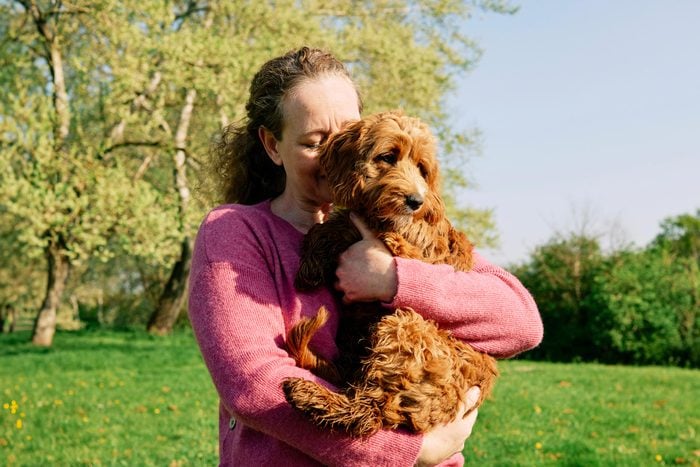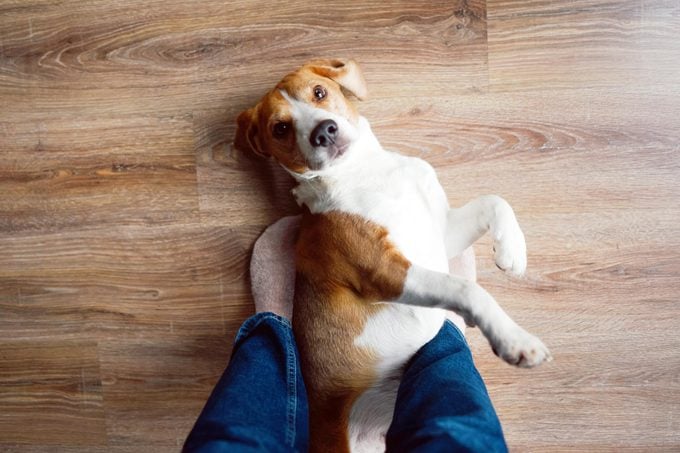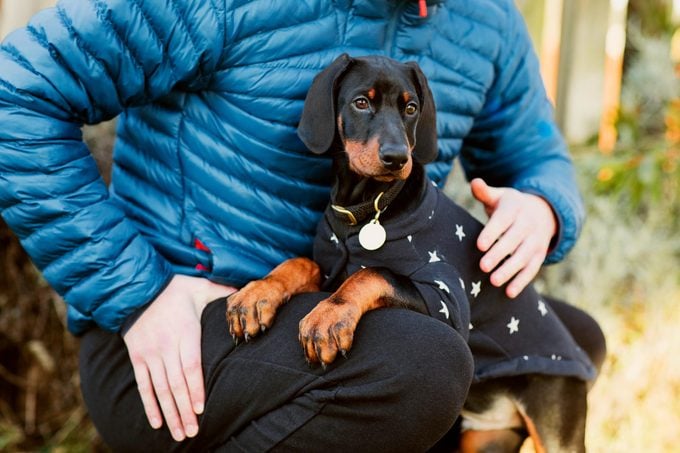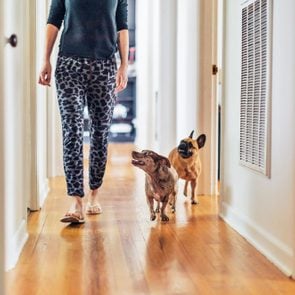This Is the Right Way to Pick Up a Dog, According to Pet Experts
Updated: Feb. 12, 2024

Picking up a pup seems pretty basic, yet well-meaning dog parents get it wrong. Whether you have a small dog or a giant breed, learn how to pick up a dog safely and comfortably.
You probably don’t give it much thought when scooping up your pup for a snuggle or hoisting your doggo into the car. It might even be part of your daily pet routine. Yet, surprisingly, even the most well-meaning dog parents get it wrong. It’s an essential part of pet parenting to know how to pick up a dog without unintentionally hurting them or making them uncomfortable.
Even if you don’t regularly pick up your tiny pooch or if you have a heavier dog too big to hoist, it’s essential to train a dog to feel secure and comfortable if and when they might need a lift. And while some dogs may never relish being picked up—you’ll know if you’re barking up the wrong tree by observing and interpreting their dog behavior—it’s good practice to arm yourself with the right knowledge. We asked experts to decode dog behavior cues and teach us how to pick up a dog safely. Plus, we have some extra tips to make the process smoother.
Get Reader’s Digest’s Read Up newsletter for pet insights, humor, cleaning, travel, tech and fun facts all week long.
Is it OK to pick up a dog?
“Not only is it OK to pick up a dog, it’s sometimes necessary,” says Jo Myers, DVM, a veterinarian at Vetster online veterinary care. For example, you might need to pick up your doggo if they need help getting into the car or scoop them up to remove them from harm’s way when there is an emergency. So it’s essential to know how to pick up a dog safely. But outside of those situations, how do dogs feel about being picked up? Look for clues in their doggy body language. Signs of a non-fearful dog include a loose body, as opposed to a stiff and rigid stance, and eyes, ears and tail that are relaxed and neutral.
“Some dogs, especially smaller ones, like getting picked up and beg for it. Others clearly find it uncomfortable and stiffen up or wiggle to escape,” says Dr. Myers. It’s essential to look for the clues in dog body language to keep you both safe. “Additionally, if there are times that you do not need to pick up a dog, then don’t,” says veterinarian Lauren Adams, DVM, owner and medical director of GoodVets James Island in Charleston, South Carolina. This could be when they are injured, recovering from surgery or showing signs of fear, pain or anxiety.
How to pick up a dog
Whether you pick up your dog daily or only when they need help getting into the car, it’s a good idea to adhere to the old safety-first adage, because picking up a dog can quickly result in injury for either party. “Read your dog’s cues, and if they’re uncomfortable about being picked up, be patient and work up to it slowly, praising them as you progress,” says Dr. Myers. A good rule of thumb is that if a dog is comfortable, they are more likely to cooperate. “If they are squirming, it is likely we need to re-adjust,” says Dr. Adams.
@leashdropcanine Picking up a puppy #dog #puppy #goldenretriever ♬ original sound – leashdropcanine
Who doesn’t want to cuddle a cute puppy or an adorable small dog in their arms? (for exploring adorable-looking dogs- check out dogs that look like mops and dogs with beards). They may not weigh too much, but puppies and small dogs can be very wiggly and could fall out of your grasp and be injured or traumatized from the negative experience. It’s a vital part of pet parenting to know how to pick up a dog safely, even when they are smaller.
-
- Give a vocal cue. Do this so they know what’s coming, says Dr. Myers. “Use the same words every time and speak in a clear, calm manner.” And be sure to use a happy tone to praise them throughout each step.
- Corral. Squat next to them, keep them corralled close to you and wait for them to hold still.
- Scoop. “Scoop one arm behind the back legs and under the tail and wrap the other arm around the front of the chest. Keep them close to your body and spread their weight evenly across both arms to avoid pressure on any one area,” says Dr. Adams.
- Stay level. Keep the dog level or heads-up while lifting.
- Keep close. “Quickly and smoothly bring them close to your body to give them a sense of security,” says Dr. Myers.
How to pick up a medium-size or large dog
You’re probably not going to be picking up medium-size dogs and large dogs, let alone giant dog breeds, very often, simply because they are heavier. Of course, that doesn’t stop them from thinking they’re a lap dog and sprawling across you on the sofa. That said, there may be occasions when you need to pick them up. Here are a few different options to try.
- Give a vocal cue. Use the same words each time you practice, speaking calmly and happily.
- Corral. Squat next to them, keep them corralled close to you and wait for them to hold still.
- Cradle correctly. Follow the options below. Choose which is right for your dog based on their comfort level and body language.
- Option 1: “Reach between their front legs from front to back, so their head is cradled next to your shoulder and your arm and hand supports their chest and belly from the bottom. Use your other hand or arm to scoop up their bottom from behind both back legs, almost as if you’re making them sit on your arm,” says Dr. Myers.
- Option 2: Another option is to scoop them up with one arm in front of both front legs and the other behind both back legs. “Use their chest and bottom to bear the weight while you bring your arms closer together to draw their legs closer to the middle of their body,” says Dr. Myers.
- Option 3: If the dog is too heavy, use two people. Lift with your legs to prevent potential back injury. Bend your knees and push up through your legs while keeping a straight back, like you’re doing a squat exercise. One person lifts with their arms under the dog’s chest while the other stands on the opposite side to lift from the dog’s belly and under their bottom.
- Option 4: “For dogs that just need a boost, consider investing in a Help’Em Up type harness,” says Dr. Adams. These sturdy, full-body lifting harnesses have handles on the hip and shoulders to safely and comfortably pick up the dog from underneath the torso.
- Stay level. Keep the dog level or slightly heads-up while lifting.
- Keep close. Quickly and smoothly, bring them close to your body to give them a sense of security.
- Continue praise. Do so in a calm, happy tone throughout.
How do you pick up a dog that won’t get up?

Quite frankly, you don’t—especially if it’s one of those things your dog wishes you’d stop doing. It’s true that some dogs love being scooped up and carried around, but generally, dogs feel more secure when all four paws are on the ground, especially larger dogs or older dogs with medical issues, such as arthritis or degenerative joint disease. Lifting them can be extremely painful.
Attempting to pick up a dog that doesn’t like being picked up or hasn’t been trained to be handled in this way could be dangerous for you both.
“A dog can be seriously injured if they panic, struggle, break free and fall,” says Dr. Myers. But if you have to pick up an injured dog that can’t get up, remember that they are frightened and may bite. Proceed only if you can do it safely. “Use a muzzle and/or cover them with a large blanket if necessary. Speak calmly throughout and make sure to hold the dog very securely while getting it over with as quickly as possible.” Alternatively, you can use a pet transport stretcher. “There are nice inexpensive stretchers that would be a great addition to any pet owner’s first-aid kit,” says Dr. Adams.
How not to pick up a dog
Now that you know the basic steps for how to pick up a dog, there are some other things to keep in mind before you scoop up your pupster. “In general, we want to avoid startling, grabbing, pulling or dangling pets from their arms, legs, tails or scruff,” says Dr. Adams. Don’t be caught off guard. Prepare yourself for the wiggles and squirms, and hold them close so they don’t fall and get hurt. When a dog is really uncomfortable about being picked up, they may also throw their heads about violently, which could hurt you both.
One of the most important things to remember is to back off if the dog responds aggressively when you attempt to pick them up. When a dog has an injury, seizure or is anxious or unfamiliar with you, they may bite if you attempt to pick them up. Still, if you find yourself in a situation where you need to get a dog to the vet, protect yourself. “Place a thick blanket or towel between yourself and the teeth when handling,” says Dr. Adams.
Can you train a dog to like being picked up?

Yes, whether you’re training a puppy or an older dog. “Most dogs can be trained to at least tolerate being picked up, and should be as a safety measure,” says Dr. Myers. Even if your dog isn’t a fan, it is essential they become familiar with the process. “It’s far better to train your dog to calmly accept being picked up and practice this skill long before it’s needed.” (Discover our list of the easiest dogs to train.)
The best way to train a dog to do anything they don’t like or are timid about is to start small and gradually progress forward. Start by having the dog stand still while you crouch down next to them. Pause before you reach around the dog with your arms. Gradually work up to holding them close to you. “The overall goal is to be able to praise them throughout and stop just before they start to protest, ending on a win,” says Dr. Myers.
Practice regularly while using positive reinforcement (treats and praise!). If you’re struggling or feel unsafe, contact a certified dog behaviorist for help.
About the experts
- Jo Myers, DVM, is a veterinarian at Vetster, an online veterinary care platform. She has 25 years in clinical practice and offers a wealth of services, including diet, nutrition and exercise, general health and wellness, behavioral issues, optimizing puppy and kitten experiences, pet grooming techniques and more. She also feels especially drawn to serving pet owners facing end-of-life issues with their beloved pets. Dr. Myers lives in Colorado and loves spending time on the trail with her canine partner, Trio, a border collie mix.
- Lauren Adams, DVM, is the owner and medical director of GoodVets James Island in Charleston, South Carolina. Her areas of interest include feline medicine and behavior, canine medicine and behavior, geriatric medicine, complex disease management, autoimmune disease, renal disease, oncology, dentistry and soft tissue surgery. Dr. Adams believes that supporting the emotional health of our pets and the people who care for them allows for stronger bonds between everyone. When she’s not practicing veterinary medicine, she loves activities that take her outside along with the company of her dog, The Fabulous Mr. Fox, and two cats, Mr. Lewis Clark and Ms. Rosie Reverse.
If you’re planning to pick a furbaby for yourself, don’t forget to check out brindle dog breeds, handsome Italian dog breeds and elegant French dog breeds.



